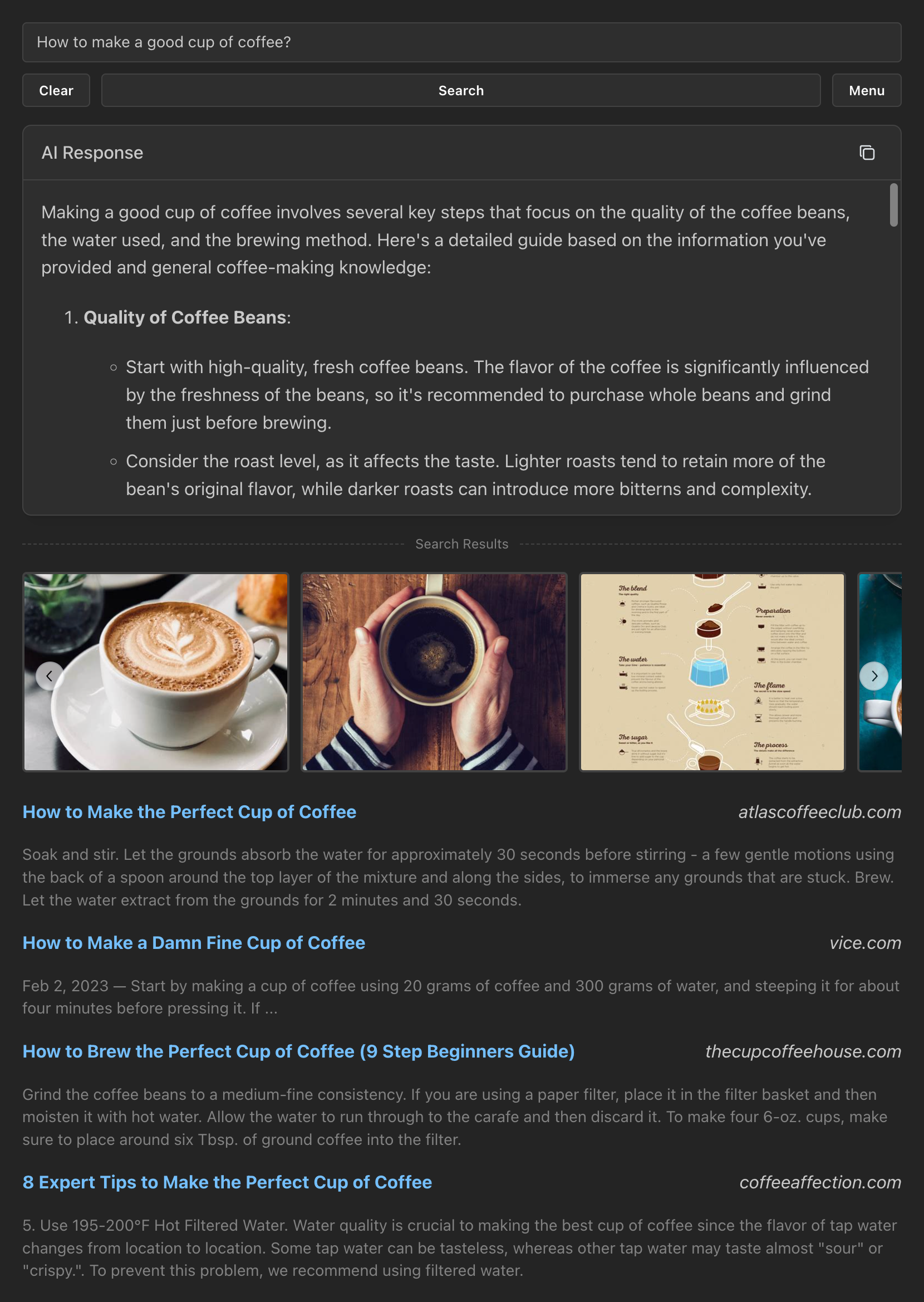Spaces:
Paused
Paused
| title: MiniSearch | |
| emoji: 👌🔍 | |
| colorFrom: yellow | |
| colorTo: yellow | |
| sdk: docker | |
| short_description: Minimalist web-searching app with browser-based AI assistant | |
| pinned: true | |
| custom_headers: | |
| cross-origin-embedder-policy: require-corp | |
| cross-origin-opener-policy: same-origin | |
| cross-origin-resource-policy: cross-origin | |
| # MiniSearch | |
| A minimalist web-searching app with an AI assistant that runs directly from your browser. | |
| Live demo: https://felladrin-minisearch.hf.space | |
| ## Screenshot | |
|  | |
| ## Features | |
| - **Privacy-focused**: [No tracking, no ads, no data collection](https://docs.searxng.org/own-instance.html#how-does-searxng-protect-privacy) | |
| - **Easy to use**: Minimalist yet intuitive interface for all users | |
| - **Cross-platform**: Models run inside the browser, both on desktop and mobile | |
| - **Integrated**: Search from the browser address bar by setting it as the default search engine | |
| - **Efficient**: Models are loaded and cached only when needed | |
| - **Customizable**: Tweakable settings for search results and text generation | |
| - **Open-source**: [The code is available for inspection and contribution at GitHub](https://github.com/felladrin/MiniSearch) | |
| ## Prerequisites | |
| - [Docker](https://docs.docker.com/get-docker/) | |
| ## Getting started | |
| There are two ways to get started with MiniSearch. Pick one that suits you best. | |
| **Option 1** - Use [MiniSearch's Docker Image](https://github.com/felladrin/MiniSearch/pkgs/container/minisearch) by running: | |
| ```bash | |
| docker run -p 7860:7860 ghcr.io/felladrin/minisearch:main | |
| ``` | |
| **Option 2** - Build from source by [downloading the repository files](https://github.com/felladrin/MiniSearch/archive/refs/heads/main.zip) and running: | |
| ```bash | |
| docker compose -f docker-compose.production.yml up --build | |
| ``` | |
| Then, open http://localhost:7860 in your browser and start searching! | |
| ## Frequently asked questions | |
| <details> | |
| <summary>How do I search via the browser's address bar?</summary> | |
| <p> | |
| You can set MiniSearch as your browser's address-bar search engine using the pattern <code>http://localhost:7860/?q=%s</code>, in which your search term replaces <code>%s</code>. | |
| </p> | |
| </details> | |
| <details> | |
| <summary>Can I use custom models via OpenAI-Compatible API?</summary> | |
| <p> | |
| Yes! For this, open the Menu and change the "AI Processing Location" to <code>Remote server (API)</code>. Then configure the Base URL, and optionally set an API Key and a Model to use. | |
| </p> | |
| </details> | |
| <details> | |
| <summary>How do I restrict the access to my MiniSearch instance via password?</summary> | |
| <p> | |
| Create a <code>.env</code> file and set a value for <code>ACCESS_KEYS</code>. Then reset the MiniSearch docker container. | |
| </p> | |
| <p> | |
| For example, if you to set the password to <code>PepperoniPizza</code>, then this is what you should add to your <code>.env</code>:<br/> | |
| <code>ACCESS_KEYS="PepperoniPizza"</code> | |
| </p> | |
| <p> | |
| You can find more examples in the <code>.env.example</code> file. | |
| </p> | |
| </details> | |
| <details> | |
| <summary>I want to serve MiniSearch to other users, allowing them to use my own OpenAI-Compatible API key, but without revealing it to them. Is it possible?</summary> | |
| <p>Yes! In MiniSearch, we call this text-generation feature "Internal OpenAI-Compatible API". To use this it:</p> | |
| <ol> | |
| <li>Set up your OpenAI-Compatible API endpoint by configuring the following environment variables in your <code>.env</code> file: | |
| <ul> | |
| <li><code>INTERNAL_OPENAI_COMPATIBLE_API_BASE_URL</code>: The base URL for your API</li> | |
| <li><code>INTERNAL_OPENAI_COMPATIBLE_API_KEY</code>: Your API access key</li> | |
| <li><code>INTERNAL_OPENAI_COMPATIBLE_API_MODEL</code>: The model to use</li> | |
| <li><code>INTERNAL_OPENAI_COMPATIBLE_API_NAME</code>: The name to display in the UI</li> | |
| </ul> | |
| </li> | |
| <li>Restart MiniSearch server.</li> | |
| <li>In the MiniSearch menu, select the new option (named as per your <code>INTERNAL_OPENAI_COMPATIBLE_API_NAME</code> setting) from the "AI Processing Location" dropdown.</li> | |
| </ol> | |
| </details> | |
| <details> | |
| <summary>How can I contribute to the development of this tool?</summary> | |
| <p>Fork this repository and clone it. Then, start the development server by running the following command:</p> | |
| <p><code>docker compose up</code></p> | |
| <p>Make your changes, push them to your fork, and open a pull request! All contributions are welcome!</p> | |
| </details> | |
| <details> | |
| <summary>Why is MiniSearch built upon SearXNG's Docker Image and using a single image instead of composing it from multiple services?</summary> | |
| <p>There are a few reasons for this:</p> | |
| <ul> | |
| <li>MiniSearch utilizes SearXNG as its meta-search engine.</li> | |
| <li>Manual installation of SearXNG is not trivial, so we use the docker image they provide, which has everything set up.</li> | |
| <li>SearXNG only provides a Docker Image based on Alpine Linux.</li> | |
| <li>The user of the image needs to be customized in a specific way to run on HuggingFace Spaces, where MiniSearch's demo runs.</li> | |
| <li>HuggingFace only accepts a single docker image. It doesn't run docker compose or multiple images, unfortunately.</li> | |
| </ul> | |
| </details> | |